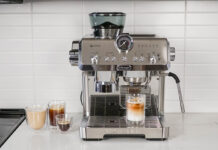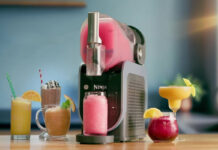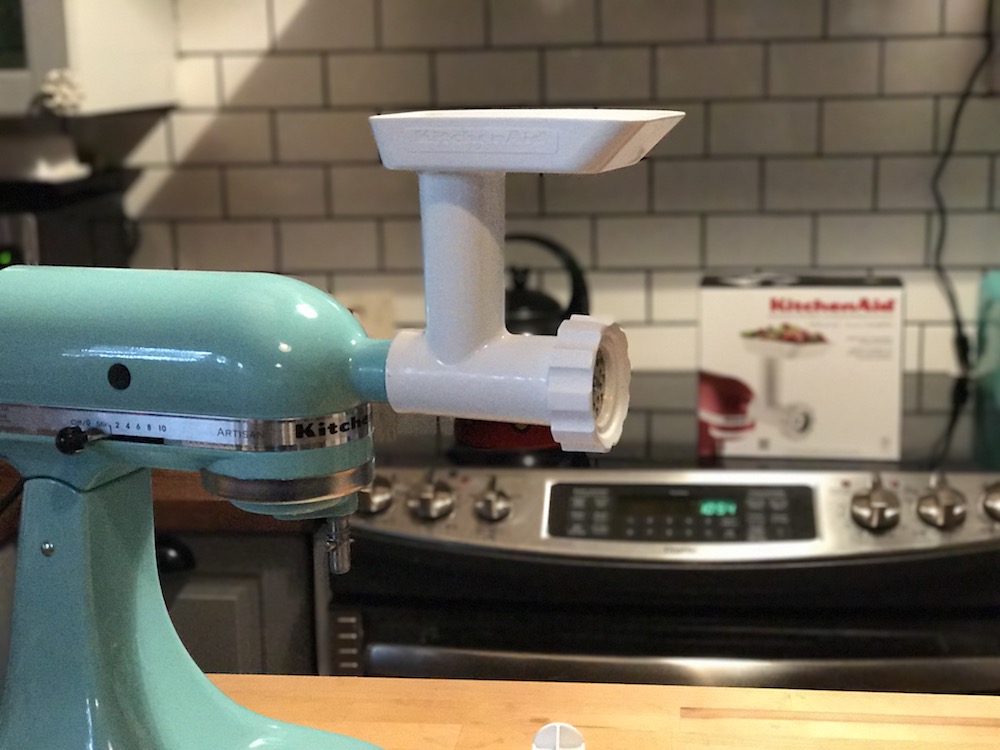 It’s week four of my KitchenAid attachment series and I’ve been having a blast trying out of all of the amazing KitchenAid attachments for my KitchenAid Stand Mixer.
It’s week four of my KitchenAid attachment series and I’ve been having a blast trying out of all of the amazing KitchenAid attachments for my KitchenAid Stand Mixer.
I’ll admit it: before I started this review series I really wondered whether or not I’d use all of these attachments in my day to day cooking and baking. I’ve been really surprised at how handy it is to have them around, and I’ve come away from each test more impressed than I was before. Even the simplest KitchenAid attachments can help you make the best meals, and that’s exactly what I discovered when I tried out the KitchenAid Food Grinder this week.
 Features of the KitchenAid Food Grinder
Features of the KitchenAid Food Grinder
It looks like a small, simple cone structure and it easily attaches to the front of your KitchenAid mixer, but the KitchenAid Food Grinder is a little powerhouse. It’s not heavy, and it’s made from durable plastic.
Inside the food grinder is a cone, blade, and an interchangeable grinding plate. When it’s attached and you turn it on, the KitchenAid Food Grinder will grinder meat, cheese, and breadcrumbs.
The KitchenAid Food Grinder works with any KitchenAid Stand Mixer.
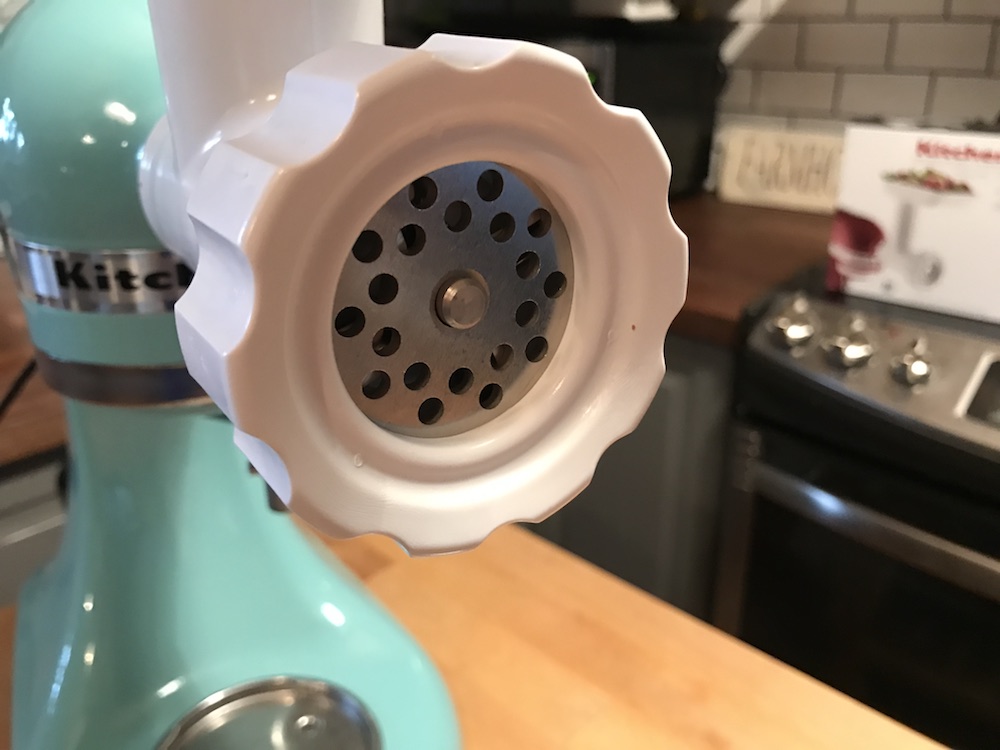 Testing the KitchenAid Food Grinder
Testing the KitchenAid Food Grinder
Once you have it mounted on the front of your KitchenAid Stand mixer you’re ready to grind. All you have to do is choose your grind plates. I opted for the course grind plate because I was going to grind up beef, and if you plan on grinding bread for bread crumbs or cheese you’ll use the fine grind plate. From the looks of it the only difference between the two are the size of the holes.
I wanted to try grinding my own beef with the KitchenAid Food Grinder. I usually buy organic beef that’s extra lean, but even then I’ve found that making burgers from the extra lean still results in a lot of fat you need to drain off. That’s one of the main reasons why I think anyone would want to grind their own meat: you can take a roast and cut away all of the excess fat before you grind it. That way you only grind what you want to grind.
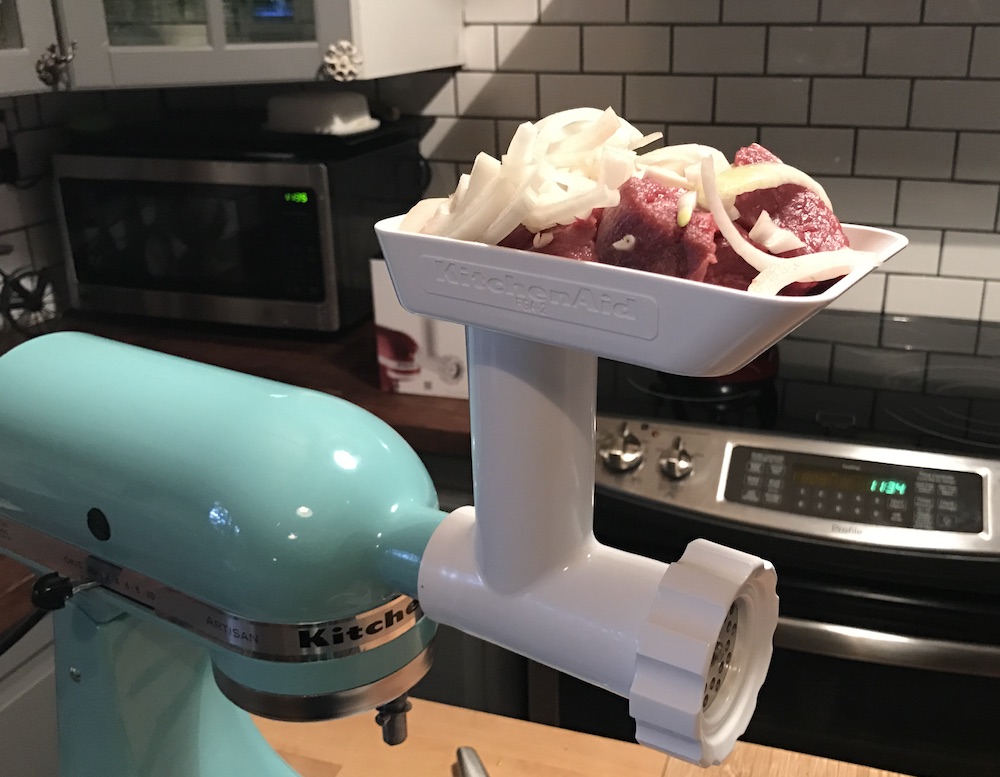 After attaching the grind plate I began cutting up my roast. You have to make the chunks fairly small, around stew size, for them to go into the chopper. Once my beef was cut up I added a few whole garlic cloves and some onion chunks to the pile of food I wanted to grind up together. I’d read how people infused flavour into their meat by grinding up herbs, spices, and vegetables with it, so I wanted to try it and see if it made a real difference.
After attaching the grind plate I began cutting up my roast. You have to make the chunks fairly small, around stew size, for them to go into the chopper. Once my beef was cut up I added a few whole garlic cloves and some onion chunks to the pile of food I wanted to grind up together. I’d read how people infused flavour into their meat by grinding up herbs, spices, and vegetables with it, so I wanted to try it and see if it made a real difference.
Once I had everything in the food tray on the top of the grinder I turned my KitchenAid Stand Mixer to speed 4 and watched the grinder go to work. It starts almost immediately, and if you notice any delay it’s probably because the chunks you’re feeding into it are too large. My chunks were the right size so it began processing almost instantly.
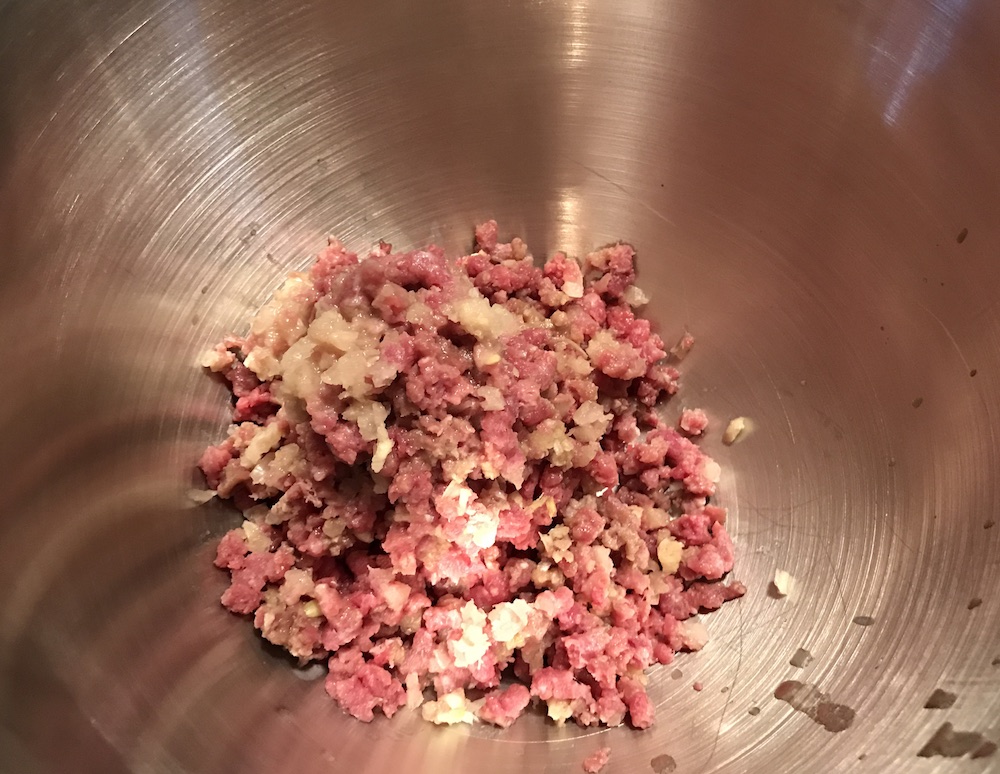 Once it had worked its way through the entire food tray of beef, garlic, onions, and spices, it was time to try out what I had made. The grind was so fine you couldn’t really see the onions and garlic within the beef, and I thought they would make the perfect burger patties.
Once it had worked its way through the entire food tray of beef, garlic, onions, and spices, it was time to try out what I had made. The grind was so fine you couldn’t really see the onions and garlic within the beef, and I thought they would make the perfect burger patties.
My favourite burger recipe is fairly simple: to ground beef I add an egg, bread crumbs, Worcestershire sauce, shredded cheese, salt, and pepper. Normally I also add in onion and garlic but that was already in the mix, so all I had to do was form the patties and grill them on my Panini press.
Two things surprised me after making these burgers. One, there was no excess fat dripping off my grill. I’ve made burgers on my press before and I always have excess fat dripping out onto a plate or the counter. There was a small drip but it was so minimal it didn’t even hit the plate.
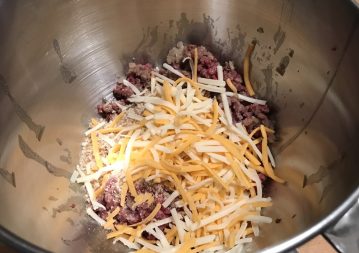 |
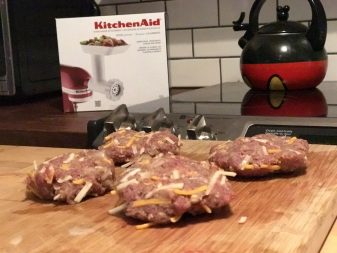 |
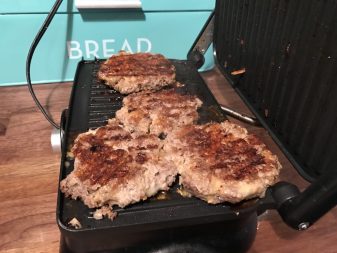
|
The other thing that surprised me was the flavour of the burgers. When you add onions and garlic and mix them into the burger it tastes good, but when you grind the onions and garlic within the meat? It’s so good it will shock you.
That’s the amazing thing about the KitchenAid Food Grinder. You can control the type of beef you want to grind and you can also control what you add to it. If it’s taco night you can add taco spices right to your roast and grind it up, then use the Food Grinder to grind up the cheese for topping.
I can only imagine how many different combinations of ingredients you can try with the KitchenAid Food Grinder.
How to clean the KitchenAid Food Grinder
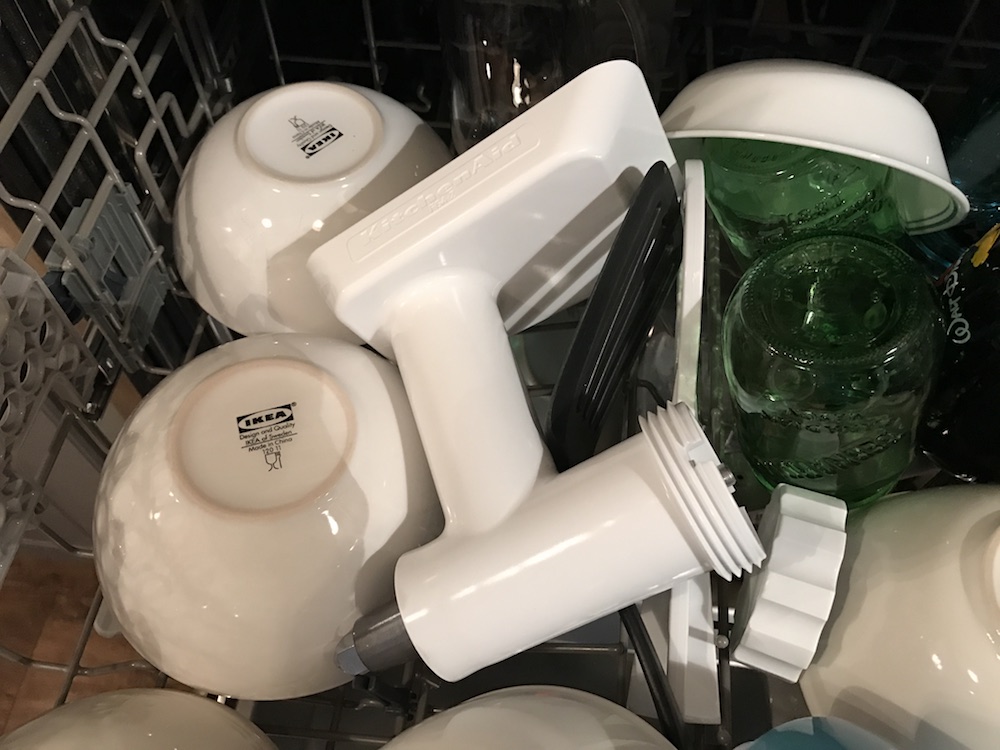 Just like the other KitchenAid attachments I’ve tried, cleaning the KitchenAid Food Grinder is really easy. The grinder itself goes into the top rack of your dishwasher as does the food tamper. The inner blade and two grinding plates will need to be washed by hand.
Just like the other KitchenAid attachments I’ve tried, cleaning the KitchenAid Food Grinder is really easy. The grinder itself goes into the top rack of your dishwasher as does the food tamper. The inner blade and two grinding plates will need to be washed by hand.
Overall thoughts on the KitchenAid Food Grinder
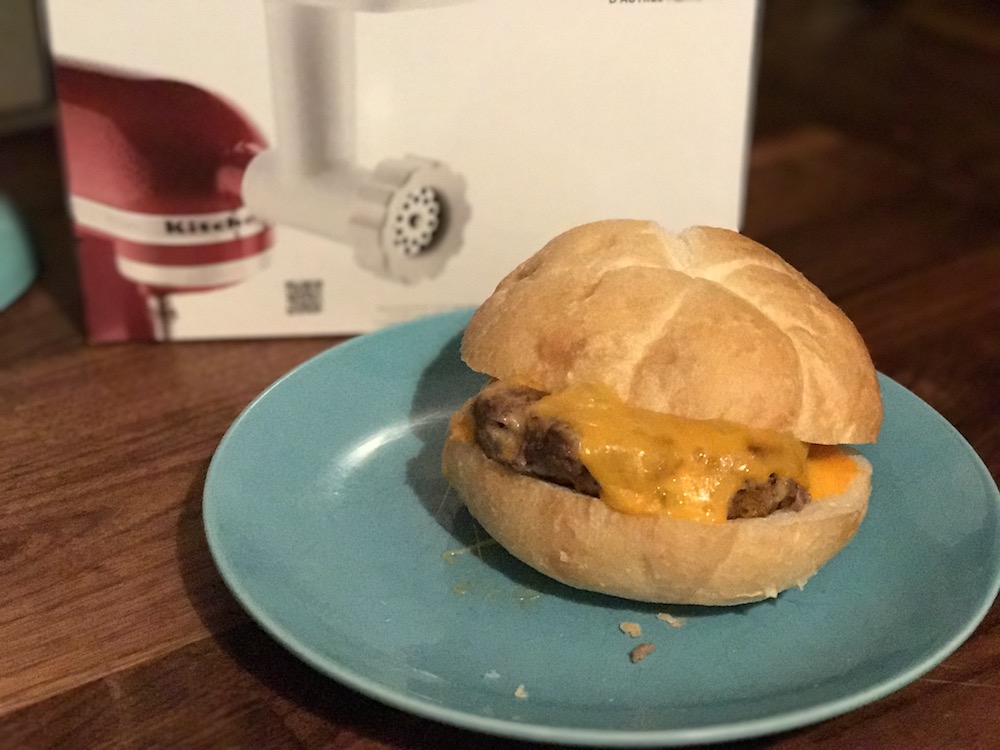 The KitchenAid Food Grinder is a fun attachment that I can see myself using all the time. Once you start grinding your own meat it becomes addicting, and with the cost of beef it’s far easier and less expensive to purchase a few large roasts and grind your own meat for different dishes. The fact that it will also grind up cheese and bread crumbs is a real bonus.
The KitchenAid Food Grinder is a fun attachment that I can see myself using all the time. Once you start grinding your own meat it becomes addicting, and with the cost of beef it’s far easier and less expensive to purchase a few large roasts and grind your own meat for different dishes. The fact that it will also grind up cheese and bread crumbs is a real bonus.
I wish I could invite everyone over to try those burgers. I made one for my husband and my dad and they both agreed, it was one of the best they’ve ever had. Grinding everything up together made for a burger that was literally bursting with flavour.
You can find your own KitchenAid Food Grinder in small appliances on Best Buy right now, and be sure to check out my other KitchenAid attachment reviews of the KitchenAid Spiralizer, KitchenAid Ravioli Maker, and KitchenAid Precise Heating mixing bowl.


